OUTDOOR FOUNTAINS
This is just a small sample of the wide selection of high-quality fountains and water features we carry at Sky.
Come on in to see even more! Photos updated May 27th, 2023.
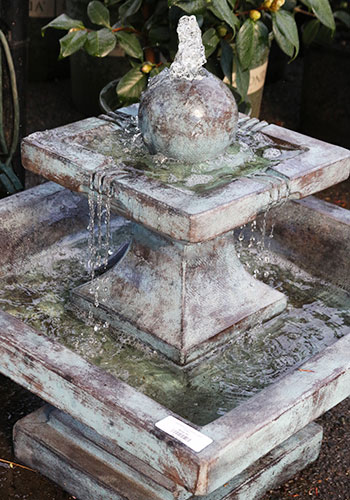
LOW EQUINOX FOUNTAIN
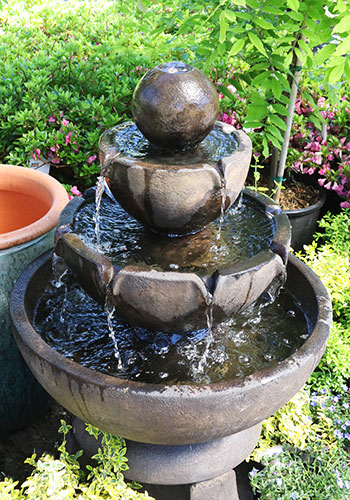
LOW STONE VESSEL PEDESTAL FOUNTAIN
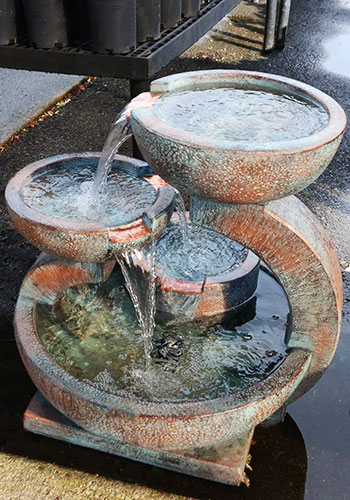
ZEN 3-BOWL FOUNTAIN
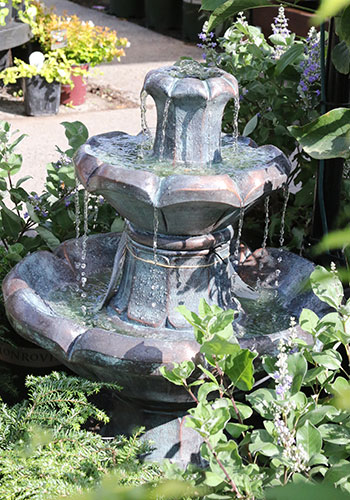
MONTREAUX 2-TIER FOUNTAIN
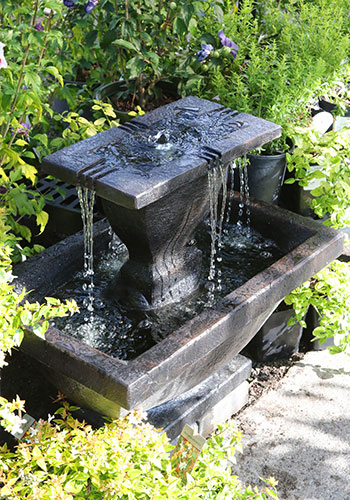
TERRAZZA FOUNTAIN
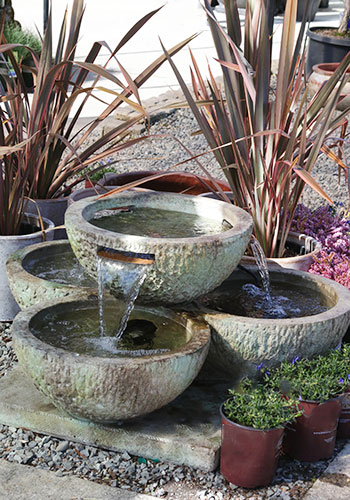
COCCO QUAD FOUNTAIN
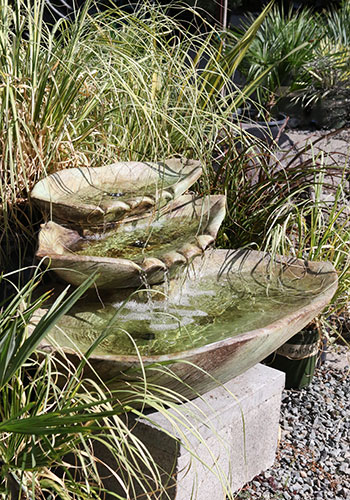
CASCADING LEAF FOUNTAIN
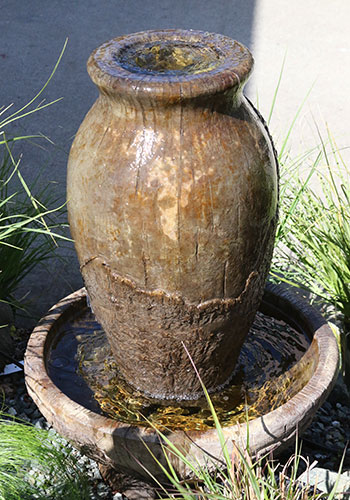
CYPRESS URN FOUNTAIN
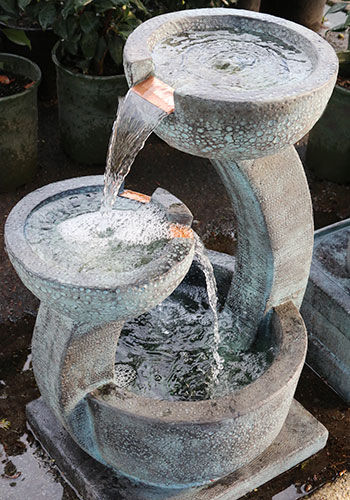
ZEN 2-BOWL FOUNTAIN
See something you like? Our stock changes quickly, so give us a call ahead of time to confirm availability.
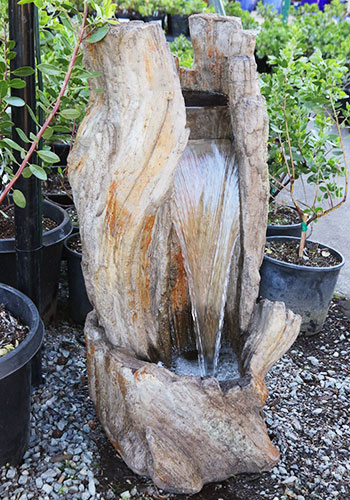
WATERFALL LOG FOUNTAIN
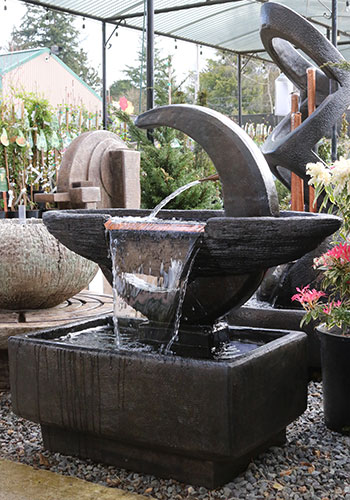
MOON DANCE FOUNTAIN
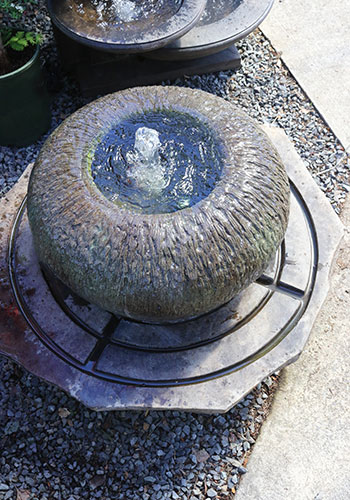
LOW ORGANIC BOWL FOUNTAIN
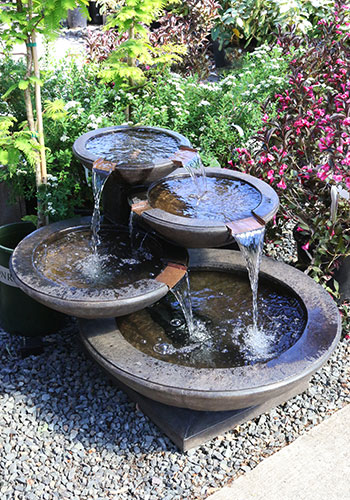
VERONA FOUNTAIN
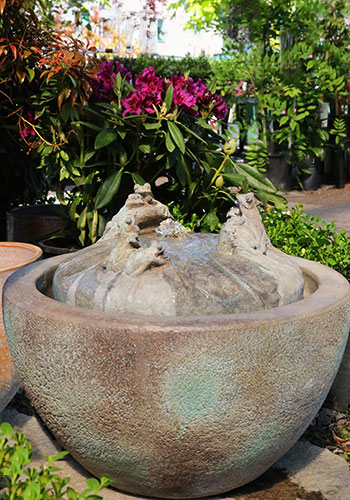
TREE FROGS FOUNTAIN
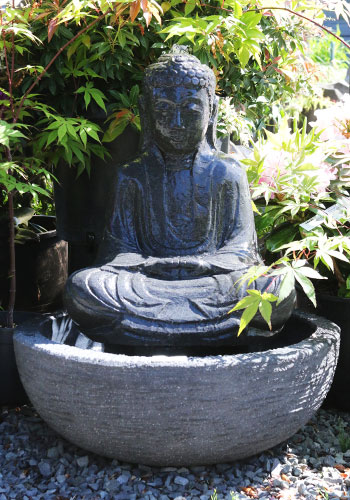
SITTING BUDDHA FOUNTAIN
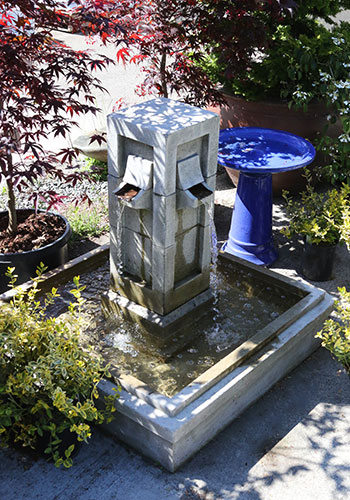
PALISADES FOUNTAIN
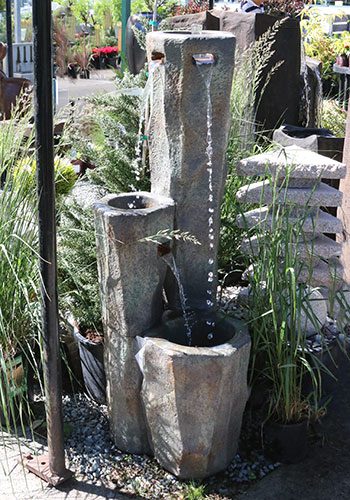
PRECIPICE FOUNTAIN
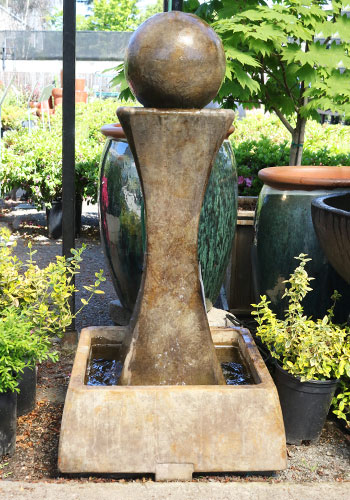
LOW HOURGLASS FOUNTAIN
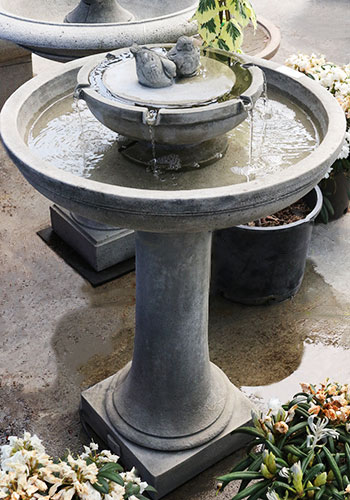
DOLCE NIDO FOUNTAIN
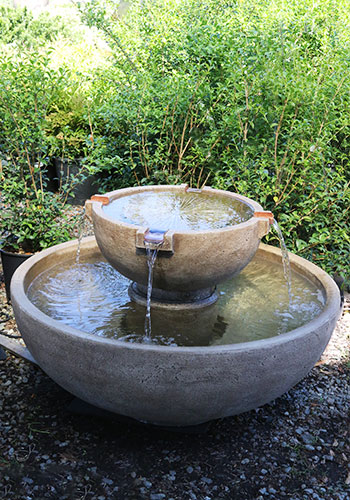
DEL REY SMALL FOUNTAIN
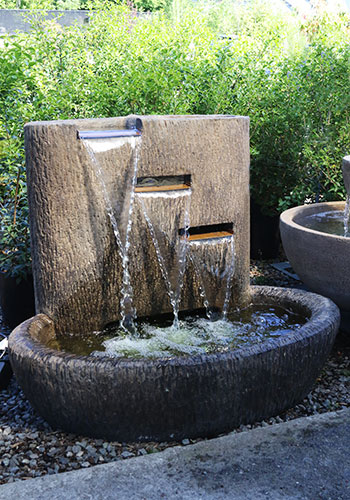
ADOBE SPRINGS FOUNTAIN
FREQUENTLY ASKED QUESTIONS
The self-contained fountains manufactured by Campania, Al’s Garden Art, or Henri are made of high-density concrete, also called cast stone. The faux basalt columns are made of ferro- cement. The glazed fountains from Pacific Home and Garden are made of frost proof ceramic. We also carry a selection of actual stone fountains.
Cast stone products will age naturally over time as they are exposed to the elements. Most of the patinas do not contain any chemical sealers and are intended to create the illusion that the cast stone has already begun its natural aging.
Part of the natural aging cycle for all cast stone material is a chemical reaction between salts found in natural materials and water. This reaction is called “efflorescence.” The degree of efflorescence will vary depending on weather conditions. When the weather is rainy, cold, or windy, calcium carbonate (salt) in the raw materials used to make cast stone will be drawn to the surface and will appear as a chalky white residue on the surface of the piece. This residue will disappear as more of the same weather conditions complete the efflorescence cycle and the chalky white residue washes away. The efflorescence process occurs only once. Efflorescence can be cleaned up if desired with a soft brush and white vinegar.
Other than efflorescence, iron oxidization is another natural occurrence that may appear on a small number of products. The raw materials for cast stone contain minimal levels of iron. When iron reacts with water a powdery pink or orange residue can appear.
Finally, bowls and basins in use are continually wet, so algae can grow. A gentle cleaning of your product with a soft cloth and rinsing (no soap!) will help to minimize build-up. We also carry a product called FOUNTEC. Using this in your fountains or bird baths will greatly reduce algae build-up on surfaces and in the water.
Pumps, tubing, stoppers and all necessary parts are included for self-contained fountains and table top ceramic and stone fountains. Basalt columns, large ceramic fountains and large stone fountains require additional components sold individually.
Sky Nursery does deliver fountains to many neighborhoods, but we do not place them or set them up. Our delivery charge for curbside delivery is based on your location and the number of people required to safely unload your fountain. Have a sales associate check your address with Sky’s office to determine your basic delivery charge.
SKY RECOMMENDED INSTALL & DELIVERY COMPANIES
Please let them know that Sky Nursery referred you to them for services. If the installer needs specs for the fountain, please direct them to the corresponding website: campaniainternational.com | henristudio.com | fiorestone.com
NW Pond & Landscape LLC | Brian Koffski
425-760-3648 nwpondandlandscape.com
Mount Olive Landscape & Construction | Norberto Guevara
425-309-9712
We recommend that you drain your fountain and remove the pump. If water is left in the pump and it freezes, there is a possibility that the pump will crack. All the fountains we carry are made to withstand our normal winter conditions if drained. However, we do recommend that you cover your fountain with some type of material to provide additional protections. We carry specially made fountain covers as well as frost protection cloth.
Most self-contained fountains are extremely easy to set up. The weight of larger pieces may be the only difficulty. Whether you are installing yourself or hiring a company to do it for you, it’s important to consider each of these details ahead of time. The more you prepare, the sooner you can enjoy your new fountain.
Foundation - The fountain must be set on a stable, level foundation of concrete or crushed gravel. Gravel should be 4 inches deep and level. For small to medium fountains and fountains on decks you can use unsupported concrete pavers with no sub-layer of gravel. An inadequate foundation can lead to:
- Fountain settling and tumbling
- Cracking due to uneven support of weight
- Moisture from the soil degrading the fountain surface
Electricity - All fountains have standard 3-prong plugs on cords extending 1 - 15 ft. from the bottom of the fountain. To power your fountain, you will need an outlet nearby. If you don’t have one, you will need to install an outlet and conduit to reach the site. Consider if you would like to bury the conduit so that the wiring is hidden. Even if you plan to setup the electrical later, make sure you have an outdoor extension cord available to test the fountain at the time of installation.
Water Source - The install team will need to fill and test the fountain, so make sure you have a water source ready to go. If installing yourself, fill the fountain to test that the fountain is level.
Structural Support - If the fountain is going on an elevated surface (ie. a deck), confirm that the location is capable of supporting the weight of both the fountain and water.
Modifications - Do you plan on making any modifications to the fountain? Some fountain owners install auto refill devices and/or lights which require a different plug and additional hosing, etc. Sky offers a great selection of plugs, lights and other fountain supplies.
Location Access - Below are some questions that will help you or a professional team safely place your new fountain. If the fountain cannot get to the site, it cannot be installed.
- Is the fountain going to a house, apartment, office etc.?
- Is the fountain going inside or outside?
- Is the fountain going in a garden? On a deck? On a patio?
- Is the fountain going in the front, back, or side yard?
- How close can the installation equipment get to the site? Are there any obstacles?
- Are there any hills or steep areas involved?
- Is there a minimum 4 ft. wide and 7 ft. tall path to the installation site?
- What type of surfaces will need to be traversed? Grass, gravel, dirt, concrete etc.?
- Are there any steps to contend with?
- If so, how many?
- What is the tread length, step height, and width of the staircase?
- Are there any switchbacks that may be tricky to navigate?
- Can a dolly carrying the fountain reasonably and safely ascend or descend? Keep in mind, some smaller 2-man fountains can be carried up narrow stairs and paths.
Pallet Jacks & Lifts - Some larger fountains have bowls and/or basins that are too heavy to carry and too large for a dolly. To move these, a pallet jack or lift may be used, or a round fountain may be carefully rolled into position. These options require no less than a 5 ft. wide, flat, concrete path with no steps or obstacles.
Basalt columns are a bit more involved since they have multiple components (see below), but homeowners can still install without much difficulty. Again, the major concern is the weight. If you have a group of people to help you carry and position the pieces, our fountain experts can walk you through the process.
Basins | Each basalt column requires a basin underneath for catchment and recirculation. We carry several different sizes of basins. These can be buried or sit above ground. Larger sizes are typically used for more than one basalt column or for a very wide fountain.
Pumps | The smaller the pump size, the less water volume. Bigger pump size, more water. More volume, more splash. Consider a larger basin or make sure the area around the fountain won’t mind getting wet.
BASALT COLUMN FOUNTAIN COMPONENTS
Below are GENERAL guidelines for set-up components for a Basalt Column fountain system:
Pump (For Single Component)
- 16-22” column – 250-350 Gallons Per Hour pump
- 28-36” column – 350-500 GPH pump
- 42-54” column – 500-900 GPH pump
- 3 Column Styles, use largest size pump indicated for height for best waterfall effects.
Pump For Multiple (Separate) Columns:
If installing more than one column, you can use multiple pumps (one per column, see above), or increase pump size. If using one pump for more than one column, you will need to purchase one of our diverter components.
- 2 Columns – 750-900 GPH
- 3 Columns – 1200-1800 GPH
- Diverter component
Additional Requirements:
- 1 - 1⁄2” x 3⁄4” bushing connects the pvc tubing in the column to your barb adaptor.
- 1 - 3⁄4” male barb adapter to screw into bushing component and attach to tubing
- Enough 3⁄4” tubing to go from column to pump, with a bit extra for pump access.
- 1- Pipe clamp to attach tubing to pump.
Recommended But Not Required:
- 2- 3⁄4” male barb adaptors
- 1 - 3⁄4” ball valve OR 1- 3⁄4” bar ball valve
- We recommend installing a valve inline with your fountain tubing to easily adjust water flow.
Large stone and ceramic fountains are a bit more involved since they have multiple components (see below), but homeowners can still install without much difficulty. Again, the major concern is the weight. If you have a group of people to help you carry and position the pieces, our fountain experts can walk you through the process.
Basins | Each large ceramic and stone fountain requires a basin underneath for catchment and recirculation. We carry several different sizes of basins. These can be buried or sit above ground. Larger sizes are typically used for a very wide fountain.
Pumps | The smaller the pump size, the less water volume. Bigger pump size, more water. More volume, more splash. Consider a larger basin or make sure the area around the fountain won’t mind getting wet.
LARGE CERAMIC FOUNTAIN COMPONENTS
All ceramic fountains are plumbed with 5/8” tubing. Depending on pump size, the size of the outlet may be different. Make sure you buy the proper tubing size for both pump & fountain. Below are GENERAL guidelines for the materials you will need to set up your ceramic fountain:
Appropriate pump size for your fountain. These should be listed with each fountain. Enough 5/8” tubing to go from pump to tubing with room to move pump around. Pipe clamps to attach tubing to pump and/or valves
Recommended But Not Required
2 - 1⁄2” male barb adaptors
1 - 1⁄2” ball valve OR 1- 1⁄2” inline t-valve
We recommend installing a valve inline with your fountain tubing to easily adjust water flow.
